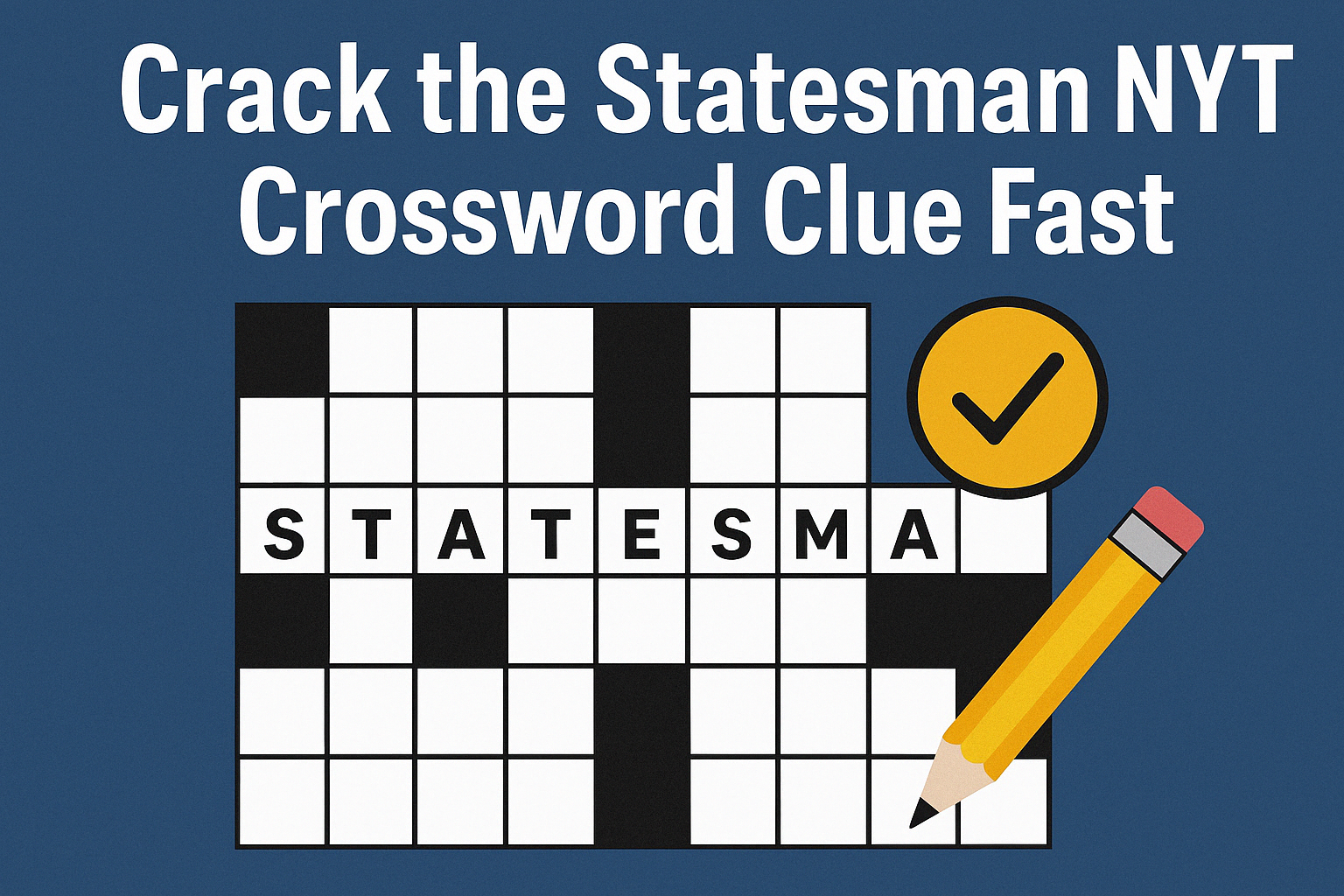
Introduction
The New York Times (NYT) Crossword is one of the most prestigious and widely solved puzzles in the world. It’s known for its clever wordplay, diverse clueing styles, and the unique challenge it presents to solvers. For both beginners and seasoned enthusiasts, clues like “Statesman” can be particularly deceptive. At first glance, it seems straightforward, but the solution often requires a deeper understanding of language, context, and crossword conventions. Cracking clues like “Statesman” quickly is not just about vocabulary; it’s about decoding layers of meaning with efficiency. This article will walk you through everything you need to know to decode the “Statesman” NYT clue fast—from clue structure and solving strategies to real examples and expert insights.
What Makes NYT Crossword Clues So Tricky?
NYT crossword clues are known for their playful ambiguity and multiple meanings. Clues are often designed to mislead you—not unfairly, but in a way that makes the solving experience more satisfying. A clue like “Statesman” might not just refer to a well-known political figure; it might hint at a general or even a metaphorical concept depending on the theme and tone of the puzzle. Clue creators often use puns, cultural references, or minimalist hints to throw solvers off. Moreover, clues are rarely literal, especially in later-week puzzles, where cryptic elements become more prevalent. These intricacies are what make the NYT crossword both beloved and formidable. Understanding how these clues are crafted is the first step to solving them faster.
Why “Statesman” Is a Popular Clue
“Statesman” is a popular crossword clue because it offers both clarity and complexity. It can easily be interpreted in multiple ways: a historical figure, a political term, or even a metaphorical description of someone wise or dignified. Puzzle editors favor this kind of clue because it balances accessibility with challenge. It doesn’t rely on obscure trivia, but it still pushes the solver to think critically. Also, it’s a term that can link with various grid answers, such as “ELDER,” “LEADER,” or even names of historical figures. Its versatility ensures that it fits in various crossword themes and difficulty levels, making it a go-to clue in the constructor’s toolkit.
Understanding Crossword Clue Structures
Types of Clue Wordplay
Clue wordplay is an art form in the NYT crossword. Some clues involve homophones, where a word sounds like the answer but is spelled differently. Others might include anagrams or hidden words. Still others rely on puns or cultural references that hint toward the answer in less direct ways. Recognizing these formats can dramatically improve your solving time. For example, the clue might be “Wise statesman,” which implies not just a politician but a respected elder or sage. The wordplay format gives you a signal that you should think beyond the surface meaning.
Synonyms and Double Meanings
NYT crossword clues often rely on synonyms that aren’t immediately obvious. For example, the clue “Statesman” could lead to “ELDER,” “DIPLOMAT,” or even “TITAN.” Understanding these kinds of double meanings is crucial. It’s not just about knowing that a statesman is a political figure; it’s also about recognizing that the term might be used metaphorically or in a different context entirely. When solving, always consider the broader semantic range of the clue. This mindset helps you match the clue with less obvious answers that still fit the definition.
Hidden Hints in Simplicity
Sometimes the simplest clues are the most deceptive. “Statesman” as a one-word clue can seem too easy, but therein lies the trick. The simplicity forces the solver to consider all possible meanings and applications of the word. Is it historical? Is it metaphorical? Could it be part of a themed puzzle? These are the questions you need to ask. Often, the lack of specificity in a simple clue like “Statesman” is precisely what makes it so complex. Training your mind to look for nuance in minimalism is key to cracking these clues quickly.
Decoding the ‘Statesman’ Clue
Literal vs. Figurative Interpretations
In the NYT crossword, literal and figurative interpretations are often blurred. The clue “Statesman” might seem like it directly points to a specific person, but many times it doesn’t. It might reference a general archetype or a metaphorical concept. For instance, it could imply someone who is not a literal politician but behaves like one in wisdom or leadership. This dual-layer meaning is a hallmark of the NYT style and must be accounted for during the solving process. Always think: could this be a play on words or a metaphor?
Common Answers Used in Past Puzzles
There are some answers that frequently pop up in response to “Statesman.” Words like “ELDER,” “SENATOR,” “LEADER,” and “ORATOR” are popular. Sometimes it could even be a surname, like “CLAY” (referring to Henry Clay) or “ADAMS.” The more you solve, the more familiar you become with these repeated answers. Building a mental database of likely responses helps immensely when you’re stuck. Reviewing past puzzles or using a crossword app to explore archived clues can also sharpen your instincts.
When “Statesman” Doesn’t Mean Politician
One of the trickiest aspects of this clue is when it breaks from its typical definition. In rare instances, “Statesman” might be used ironically or metaphorically. It could refer to a wise figure in literature, or a diplomatic thinker in mythology. It might even relate to someone admired in sports or business contexts if the puzzle has a modern theme. This level of abstraction means solvers need to keep an open mind. The more flexible your thinking, the more effective your solving becomes.
Popular Solutions to the Clue
Top Guesses and Their Meanings
Some of the most popular guesses for “Statesman” include words like “ELDER,” which emphasizes wisdom, or “DIPLOMAT,” highlighting international relations. Each possible answer carries a different nuance, and recognizing these subtleties can help you zero in on the right one. “LEADER” might be the answer in a puzzle with a military or political theme. Meanwhile, “SENATOR” could fit if the puzzle leans toward U.S. governance. Knowing these distinctions helps you eliminate wrong guesses faster and make better choices.
Famous Statesmen in Crossword History
NYT crosswords have featured a variety of well-known statesmen over the years. Names like “CLAY,” “ADAMS,” “CHURCHILL,” and “MANDELA” have all made appearances. These figures are not only historically significant but also frequently used because their names are crossword-friendly. If you know common statesman-related names that fit standard grid lengths, you’re at an advantage. Historical knowledge combined with crossword experience makes it easier to predict the right answer.
How Puzzle Difficulty Affects the Answer
As the NYT puzzle gets harder throughout the week, clues like “Statesman” become more cryptic. On Monday, the answer might be straightforward like “LEADER.” By Saturday, it could be something poetic or metaphorical. Puzzle creators often escalate the level of misdirection as the week progresses. Understanding this trend can help you adjust your expectations accordingly. If you’re solving a Thursday puzzle with a theme, for example, remember the answer might relate to that theme rather than the direct definition of the word.
NYT Crossword Patterns and Trends
How Often ‘Statesman’ Appears
The word “Statesman” doesn’t appear in every puzzle but is recurring enough to be worth studying. It’s typically seen in puzzles with political or historical themes, and often in early-week or mid-week puzzles. Analyzing frequency patterns using crossword databases or apps can give you insights into when and how it shows up. This kind of preparation arms you with better expectations, making it easier to recognize the clue and respond quickly when it does appear.
Days of the Week and Clue Complexity
The day a puzzle is published greatly influences the difficulty of the clue. A Monday clue like “Statesman” is more likely to have a literal and easy answer, such as “ELDER” or “LEADER.” However, a Saturday or Sunday clue might involve layered meanings, indirect references, or puns. Knowing this, you can calibrate your solving approach based on the day. If you’re solving on a Friday, be ready for a clue that makes you think twice—or even thrice.
Editors’ Style and Word Choice Patterns
Each NYT crossword editor has a unique style, and their preferences affect clue construction. Will Shortz, for example, is known for favoring clever, witty clues with layered meanings. Recognizing an editor’s style helps you predict how a clue might be framed. Over time, you may begin to see patterns not just in the clues but in how they are phrased. Keeping track of these patterns gives you a powerful advantage as a solver.
Tools and Strategies for Solving Clues
Crossword Solving Apps and Resources
Digital tools can greatly enhance your solving abilities. Apps like Crossword Solver, OneLook, and the NYT Crossword archive offer instant access to past puzzles and possible solutions. These tools allow you to explore different meanings, check letter fits, and learn from past clues. While relying on them exclusively is not recommended for learning, they are excellent for practice and pattern recognition. Over time, these resources help build your speed and accuracy.
Word Associations and Memory Tricks
Training your brain to make associations is a proven way to improve crossword skills. When you see “Statesman,” you should automatically think of words like “ORATOR,” “LEADER,” and “DIPLOMAT.” Using mnemonic devices or mental flashcards can help reinforce these associations. The more connections you build, the easier it becomes to pull the right answer from memory, especially under pressure.
Elimination Methods That Work
Sometimes the best approach is not finding the right answer, but ruling out the wrong ones. By checking how each potential answer fits with crossing clues, you can eliminate choices that don’t align. This process of deduction is vital, particularly in harder puzzles. If a five-letter word ends with “R,” you can narrow down your list significantly. The process of elimination saves time and increases accuracy.
Real Puzzle Examples with ‘Statesman’
Classic NYT Puzzles Featuring This Clue
In past NYT puzzles, “Statesman” has led to answers like “CLAY,” “ELDER,” and “SENATOR.” Each puzzle offers a different take on the word depending on the theme and grid constraints. Reviewing classic puzzles helps you see the range of interpretations and prepares you for similar setups in future games.
Step-by-Step Breakdown of the Logic
Take a past puzzle where “Statesman” led to “CLAY.” The clue seems simple, but only those who knew Henry Clay could make the connection. First, the solver had to consider historical politicians. Then, cross-check the grid for fitting letters. Finally, confirm the historical role. This logical breakdown illustrates how context, knowledge, and deduction combine for success.
Lessons Learned from Solving Samples
By solving examples, you learn how clues evolve across puzzles. You start seeing how similar clues are phrased, what answers they lead to, and how often misdirection is used. This cumulative experience boosts your skills, enabling faster and more accurate solving over time.
Why Context Matters
Reading the Grid for Better Guesses
One clue alone doesn’t tell the whole story. You must look at the surrounding clues to make the best guess. If the surrounding words form a political theme, then “Statesman” is more likely to be literal. If the puzzle theme is abstract, then the answer could be metaphorical. Context gives clues a frame of reference, and using that frame improves your odds.
Cross-Referencing with Nearby Clues
Always cross-check your guesses with intersecting answers. If “Statesman” intersects with a known answer like “SENATE” or “HONOR,” you’ll get hints about the intended answer. This strategy minimizes errors and maximizes solving efficiency. The more intersections you validate, the stronger your overall puzzle confidence.
Theme-Based Puzzle Interpretations
NYT puzzles often have themes that guide clue meanings. If the puzzle theme involves diplomacy or world leaders, the answer to “Statesman” might be more literal. In a puzzle about wisdom or aging, the clue might skew metaphorical. Identifying the theme early helps you interpret each clue correctly within that framework.
Common Mistakes and How to Avoid Them
Overthinking Simple Clues
One of the most common errors is overcomplicating straightforward clues. Just because it’s the NYT doesn’t mean every clue is cryptic. Sometimes, “Statesman” simply means “ELDER.” Training yourself to first consider the simplest meanings can prevent unnecessary confusion.
Ignoring Crossword Formatting Patterns
Grid patterns and answer lengths offer critical clues. Ignoring them leads to wasted effort. Always count the letters, check if it’s plural or singular, and see if it ends in a vowel or consonant. These hints narrow down your options before you even begin guessing.
Misinterpreting Clue Tone
Tone matters. If the puzzle is humorous, “Statesman” might be ironic. If it’s serious, it’s probably literal. Pay attention to the puzzle’s mood and the editor’s choice of words. Misreading tone is a subtle but serious mistake that can lead you astray.
Learning from Crossword Experts
What Pro Solvers Say About NYT Clues
Top crossword solvers recommend staying flexible and open-minded. According to many pros, clues like “Statesman” are solvable faster when you train your brain to think laterally. Don’t lock into a single interpretation too early. Let your brain explore different meanings and use the crossings to guide you.
Insider Tips from Puzzle Creators
Puzzle constructors often share insights into how they build clues. Many say they intentionally craft clues with multiple layers. Knowing this can help you understand the clue’s intention. Try reading blogs or interviews with constructors to gain deeper insight into clue design and purpose.
Building a Solving Routine
Consistency builds skill. Solving daily and reviewing past puzzles builds pattern recognition and intuition. Use a journal to track tough clues and their answers. Over time, your solving speed improves as your brain adapts to the crossword’s logic.
Conclusion
Mastering Clues Like “Statesman”
Decoding the “Statesman” clue in the NYT crossword is about more than knowing a definition. It’s about recognizing patterns, applying logic, and thinking creatively. With the right strategies, anyone can improve their solving skills and tackle even the most deceptive clues.
Final Thoughts on NYT Puzzle Success
The NYT crossword is a mental workout that rewards persistence and creativity. Every clue you solve builds your confidence and skill. Keep practicing, and soon even tricky clues like “Statesman” will become second nature.
FAQs
What does ‘statesman’ mean in the NYT crossword?
In the NYT crossword, “statesman” usually refers to a respected political figure or wise leader. But sometimes it can mean someone with experience or authority, even outside politics. It depends on the puzzle’s theme.
Who is a common answer for ‘statesman’ clue?
Common answers include “ELDER,” “CLAY,” “LEADER,” or “SENATOR.” These words fit the general idea of a respected or senior figure. The right answer depends on the number of letters and other crossing words in the puzzle.
Why is the clue ‘statesman’ tricky?
It’s tricky because “statesman” can mean different things. Some puzzles use it literally (a politician), while others use it metaphorically (a wise person). That’s what makes solving it fun—and sometimes frustrating!
How often does ‘statesman’ appear in NYT puzzles?
It appears from time to time, especially in puzzles with political, historical, or leadership themes. You won’t see it every week, but it’s a familiar clue that experienced solvers recognize quickly.
What’s the best way to solve the ‘statesman’ clue fast?
First, think of synonyms like “leader,” “elder,” or “diplomat.” Then check the crossing words for hints. Use solving tools or apps if needed. The more puzzles you solve, the easier it gets to recognize answers like this!





